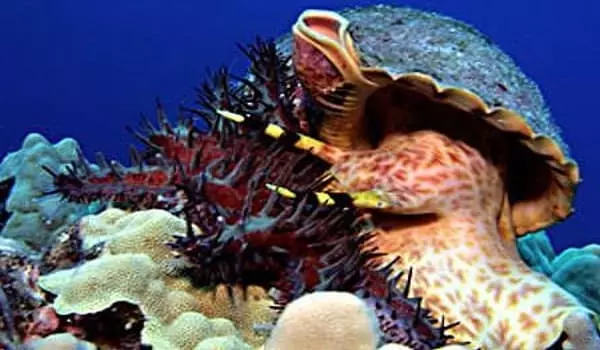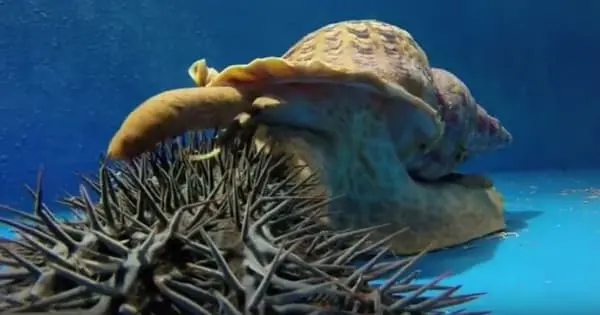Reef fish like emperors, tropical snappers, and rockcods help keep crown-of-thorns starfish numbers in check on the Great Barrier Reef. According to new research, the abundance of coral-eating starfish increases in areas where fish species, particularly those that eat the starfish, are removed.
Crown-of-thorns starfish (Acanthaster spp.) are native to Indo-Pacific coral reefs. When found in large numbers, they are a major contributor to coral loss because they feed on the living tissue of many hard coral species. Since the 1960s, four outbreaks have occurred on the Great Barrier Reef, the most recent of which is still ongoing. Crown-of-thorns starfish are coral-eating marine invertebrates. They occur naturally on reefs throughout the Indo-Pacific region, and when conditions are favorable, they can spread like wildfire and devastate hard coral communities.
“Concerns were raised more than 50 years ago that the removal of predators might contribute to starfish outbreaks. However, at the time, only one starfish predator was known, the giant triton sea snail” According to Dr. Frederieke Kroon, AIMS ecologist and lead author.
We discovered that the density of crown-of-thorn starfish increased in areas where more reef fish biomass was harvested. This relationship was particularly strong for emperors, particularly redthroat and spangled emperors, which are both well-known predators of crown-of-thorns starfish.
Dr. Frederieke Kroon
“According to recent research, nearly a hundred species of coral reef organisms feed on different stages of the starfish’s life. Eighty are fish, including popular seafood species like emperors, tropical snappers, and rockcods. This is the first study to look at how fisheries harvests of these fish species affect starfish abundance.”
First, the team compared AIMS’ long-term coral reef fish and starfish abundance data collected at reefs that were open to fishing and reefs that were closed to fishing. The biomass of emperors, snappers, and rock cods was 1.4 to 2.1 times higher and starfish densities were nearly three times lower on reefs closed to fishing than on reefs open to fishing.
“No-take marine reserves are well known for increasing fish biomass and diversity of large fishes. Previous research has suggested that marine reserves may have an impact on starfish populations, but our findings show that there are fewer crown-of-thorns starfish on reefs with more predatory fish “Dr. Kroon stated.
The researchers also compared 30 years of Queensland Department of Agriculture and Fisheries reef fish harvest data with AIMS’ long-term reef monitoring data on crown-of-thorns starfish abundance over the same time period.

According to Dr. Kroon, the relationship between fisheries harvests and starfish numbers is striking. “We discovered that the density of crown-of-thorn starfish increased in areas where more reef fish biomass was harvested,” she said. “This relationship was particularly strong for emperors, particularly redthroat and spangled emperors [Lethrinus miniatus and L. nebulosus], which are both well-known predators of crown-of-thorns starfish.”
The relationship was also strong for tropical snappers and rockcods, including coral trout (Plectropomus spp. and Variola spp.).
“We’re curious about this relationship because adult coral trout aren’t known to eat crown-of-thorns starfish. As part of their invertebrate diet, juvenile coral trout may consume small starfish, according to one theory “Dr. Kroon stated. “Our findings suggest that removing emperors, tropical snappers, and rockcods contributes to increases in starfish numbers.”
The findings have given researchers the opportunity to look into new tools for controlling outbreaks on the Great Barrier Reef and possibly elsewhere in the Indo-Pacific, such as targeted fisheries management.
“Starfish outbreaks continue to be a major cause of coral loss, but unlike other pressures such as climate change, they can be managed at the local and regional levels,” Dr Kroon explained. “Targeted fisheries-based management, in conjunction with current crown-of-thorns starfish management interventions such as direct manual control, could help control outbreaks further.”
The findings, according to Dr. Kroon, make a significant contribution to understanding possible drivers of starfish outbreaks, such as the starfish’s natural tendency to reproduce in large numbers and the role of water quality, as they are not mutually exclusive.
“It’s very likely that the outbreaks are caused by a combination of factors,” she said. “Large-scale, long-term data, like those used in this study, as well as experimental studies, are the best scientific tools we have to help understand the complexities of crown-of-thorns starfish outbreaks and implement effective and efficient management interventions for their control.”





